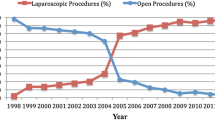Abstract
Background and Aims
The Nationwide Inpatient Sample (NIS) of the Healthcare Cost and Utilization Project (HCUP) was used to study the demographic characteristics of achalasia patients.
Methods
HCUP data from 1997 to 2006 were stratified by categories pertaining to patient demographics, such as age, sex, race, income, residence in metropolitan area, and region of the United States, as well as categories pertaining to hospital characteristics, such teaching status, location, and bed size. The distributions of inpatients among different categories were compared between achalasia and all other diagnoses, using odds ratios and their 95% confidence intervals for comparison.
Results
The annual hospitalization rates of achalasia revealed a clear-cut age-dependent rise between the youngest age group less than 18 years old (0.25/100,000) and the oldest age group over 85 years old (37.35/100,000). Between 1997 and 2007, the rates of hospitalization remained largely unchanged for all age groups alike. Achalasia was equally distributed among men and women and among various ethnic groups. Compared with other diagnoses, achalasia was more frequent among hospitalized patients from zip codes associated with a higher average income (1.26, 1.23–1.29), living in metropolitan areas (1.12, 1.09–1.15), and living in the northeast region of the United States (1.27, 1.25–1.30). Achalasia patients were mostly seen in large hospitals (1.22, 1.19–1.26), teaching hospitals (1.73, 1.70–1.76), and hospitals located in metropolitan areas (1.15, 1.14–1.15).
Conclusions
With exception of its striking age-dependence, the epidemiology of achalasia does not reveal any clues about its yet unsolved etiology.



Similar content being viewed by others
References
Park W, Vaezi MF. Etiology and pathogenesis of achalasia: the current understanding. Am J Gastroenterol. 2005;100(6):1404–1414. doi:10.1111/j.1572-0241.2005.41775.x.
Mayberry JF. Epidemiology and demographics of achalasia. Gastrointest Endosc Clin N Am. 2001;11(2):235–248.
Farhoomand K, Connor JT, Richter JE, Achkar E, Vaezi MF. Predictors of outcome of pneumatic dilation in achalasia. Clin Gastroenterol Hepatol. 2004;2(5):389–394. doi:10.1016/S1542-3565(04)00123-5.
Eckardt VF, Hoischen T, Bernhard G. Life expectancy, complications, and causes of death in patients with achalasia: results of a 33-year follow-up investigation. Eur J Gastroenterol Hepatol. 2008;20(10):956–960. doi:10.1097/MEG.0b013e3282fbf5e5.
Pandolfino JE, Kwiatek MA, Nealis T, Bulsiewicz W, Post J, Kahrilas PJ. Achalasia: anew clinically relevant classification by high-resolution manometry. Gastroenterology. 2008;135(5):1526–1533. doi:10.1053/j.gastro.2008.07.022.
Overview of HCUP. Agency for Healthcare Research and Quality, Rockville, MD. Available at: http://www.hcup-us.ahrq.gov/overview.jsp. Accessed December 28, 2008.
United States Department of Health & Human Services. Agency for Healthcare Research and Quality. HCUPnet. Available at: http://hcupnet.ahrq.gov/. Accessed December 28, 2008.
United States Department of Health and Human Services (US DHHS), Centers for Disease Control and Prevention (CDC), National Center for Health Statistics (NCHS), Office of Analysis and Epidemiology (OAE), Compressed Mortality File (CMF) on CDC WONDER On-line Database. Available at: http://wonder.cdc.gov/. Accessed December 28, 2008.
Farrukh A, DeCaestecker J, Mayberry JF. An epidemiological study of achalasia among the South Asian population of Leicester, 1986–2005. Dysphagia. 2008;23(2):161–164. doi:10.1007/s00455-007-9116-1.
Birgisson S, Richter JE. Achalasia in Iceland, 1952–2002: an epidemiologic study. Dig Dis Sci. 2007;52(8):1855–1860. doi:10.1007/s10620-006-9286-y.
Mayberry JF, Rhodes J. Achalasia in the city of Cardiff from 1926 to 1977. Digestion. 1980;20(4):248–252. doi:10.1159/000198446.
Howard PJ, Maher L, Pryde A, Cameron EW, Heading RC. Five-year prospective study of the incidence, clinical features, and diagnosis of achalasia in Edinburgh. Gut. 1992;33(8):1011–1015. doi:10.1136/gut.33.8.1011.
Mayberry JF, Atkinson M. Variations in the prevalence of achalasia in Great Britain and Ireland: an epidemiological study based on hospital admissions. Q J Med. 1987;62(237):67–74.
Sonnenberg A, Massey BT, McCarty DJ, Jacobsen SJ. Epidemiology of hospitalization for achalasia in the United States. Dig Dis Sci. 1993;38(2):233–244. doi:10.1007/BF01307540.
Arber N, Grossman A, Lurie B, et al. Epidemiology of achalasia in central Israel. Rarity of esophageal cancer. Dig Dis Sci. 1993;38(10):1920–1925. doi:10.1007/BF01296119.
Mikaeli J, Farrokhi F, Bishehsari F, Mahdavinia M, Malekzadeh R. Gender effect on clinical features of achalasia: a prospective study. BMC Gastroenterol. 2006;6:12. doi:10.1186/1471-230X-6-12.
Silber W. The prevalence, course and management of some benign oesophageal diseases in the Black population. The Groote Schuur Hospital experience. S Afr Med J. 1983;63(25):957–959.
Stein CM, Gelfand M, Taylor HG. Achalasia in Zimbabwean blacks. S Afr Med J. 1985;67(7):261–262.
Shavers VL, Shavers BS. Racism and health inequity among Americans. J Natl Med Assoc. 2006;98(3):386–396.
Owens GM. Gender differences in health care expenditures, resource utilization, and quality of care. J Manag Care Pharm. 2008;14(Suppl 3):2–6.
Conflict of Interests Statement
No financial support was received for this study. The author has no personal interests to declare.
Author information
Authors and Affiliations
Corresponding author
Rights and permissions
About this article
Cite this article
Sonnenberg, A. Hospitalization for Achalasia in the United States 1997–2006. Dig Dis Sci 54, 1680–1685 (2009). https://doi.org/10.1007/s10620-009-0863-8
Received:
Accepted:
Published:
Issue Date:
DOI: https://doi.org/10.1007/s10620-009-0863-8




